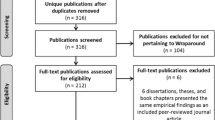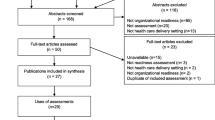Abstract
Several necessary system and organizational support conditions for wraparound have been identified (Walker et al. 2003). Yet, the relationship between these necessary system level conditions and wraparound fidelity has only recently begun to be examined. Similarly, few studies have included a measure of wraparound fidelity when examining the relationship between wraparound implementation and youth outcomes. The statewide implementation of a wraparound demonstration grant offers the opportunity to explore these relationships and to identify factors that predict improvement in functioning for youth receiving wraparound. Findings suggest that significant relationships exist between (1) the stage of development of necessary support conditions for wraparound and wraparound fidelity and (2) wraparound fidelity and improvement in youth outcomes. Specific elements of wraparound (i.e., outcomes based and community based) and baseline needs and strengths (e.g., high levels of anxiety and conduct issues, poor functioning at home and in school, judgment, and risks) were found to predict a reduction in youth needs. Other unexpected relationships between youth outcomes and the cultural competence element of wraparound and being multi-racial were also discovered. These findings reinforce the importance of supporting high fidelity wraparound for youth and their families in a recovery focused behavioral health system.


Similar content being viewed by others
References
Anderson, R. L., Lyons, J. S., Giles, D. M., Price, J. A., & Estes, G. (2003). Examining the reliability of the Child and Adolescent Needs and Strengths-Mental Health (CANS-MH) Scale from two perspectives: A comparison of clinician and researcher ratings. Journal of Child and Family Studies, 12, 279–289.
Bertram, R. M., Suter, J. C., Bruns, E. J., & O’Rourke, K. E. (2010). Implementation research and wraparound literature: Building a research agenda. Journal of Child and Family Studies. doi:10.1007/s10826-010-9430-3.
Bruns, E. J., Burchard, J. D., Suter, J. C., Leverentz-Brady, K., & Force, M. M. (2004). Assessing fidelity to a community-based treatment for youth: The Wraparound Fidelity Index. Journal of Emotional and Behavioral Disorders, 12(2), 79–89.
Bruns, E. J., Leverentz-Brady, K. M., & Suter, J. C. (2005). Is it wraparound yet? Determining fidelity standards for the wraparound fidelity index. In C. Newman, C. Liberton, K. Kutash, & R. M. Friedman (Eds.), The 18th annual proceedings, a system of care for children’s mental health: Expanding the research base (pp. 185–190). Tampa, FL: University of South Florida, The Louis de la Parte Florida Mental Health Institute, Research and Training Center for Children’s Mental Health.
Bruns, E. J., Rast, J., Peterson, C., Walker, J., & Bosworth, J. (2006a). Spreadsheets, service providers, and the statehouse: Using data and the wraparound process to reform systems for children and families. America Journal of Community Psychology, 38, 201–212.
Bruns, E. J., & Suter, J. C. (2010). Summary of the wraparound evidence base. In E. J. Bruns & J. S. Walker (Eds.), The resource guide to wraparound. Portland, OR: National Wraparound Initiative.
Bruns, E., Suter, J., Force, M., Sather, A., & Leverentz-Brady, K. (2007). Wraparound fidelity index 4.0: Manual for training, administration, and scoring of the WFI 4.0, August 13, 2007 version. Seattle, WA: Wraparound Evaluation and Research Team, Department of Psychiatry & Behavioral Sciences, University of Washington.
Bruns, E. J., Suter, J. C., & Leverentz-Brady, K. M. (2006b). Relations between program and system variables and fidelity to the wraparound process for children and families. Psychiatric Services, 57, 1586–1593.
Bruns, E. J., Walker, J. S., & The National Wraparound Initiative Advisory Group. (2008). Ten principles of the wraparound process. In E. J. Bruns & J. S. Walker (Eds.), The resource guide to wraparound. Portland, OR: National Wraparound Initiative, Research and Training Center for Family Support and Children’s Mental Health.
Bruns, E. J., Walker, J. S., Zabel, M., Matarese, M., Estep, K., Harburger, D., et al. (2010). Intervening in the lives of youth with complex behavioral health challenges and their families: The role of the wraparound process. American Journal of Community Psychology, 46, 314–331.
Choices, Inc. (2010). Training and consultation. Retrieved November 6, 2010 from http://www.choicesteam.org/tacenter.html.
Cox, K., Baker, D., & Wong, M. A. (2010). Wraparound retrospective: Factors predicting positive outcomes. Journal of Emotional and Behavioral Disorders, 18, 3–13.
Doucette, A. (2007). Measurement properties: Child and adolescent needs and strengths (CANS). 4th annual CANS conference, Boston, October.
Effland, V. S. (2009). Monthly site assessment rating guide. Indianapolis, IN: Choices TA Center, Choices, Inc.
Fixsen, D. L., Naoom, S. F., Blasé, K. A., Friedman, R. M., & Wallace, F. (2005). Implementation research: A synthesis of the literature. Tampa, FL: University of South Florida, Louis de la Parte Florida Mental Health Institute, The National Implementation Research Network (FMHI Publication #231).
George, E. R. (2010). Community-based alternatives to PRTF. Presentation at the 23rd annual children’s mental health research & policy conference, March 2010. Tampa, FL: University of South Florida.
Glisson, C., & Schoenwald, S. K. (2005). The ARC organizational and community intervention strategy for implementing evidence-based children’s mental health treatments. Mental Health Service Research, 70(4), 243–259.
Henggeler, S. W., Melton, G. B., Scherer, D. G., & Hanley, J. H. (1997). Multisystemic therapy with violent and chronic juvenile offenders and their families: The role of treatment fidelity in successful dissemination. Journal of Consulting and Clinical Psychology, 65(5), 821–833.
Lehman, W., Greener, J., & Simpson, D. (2002). Assessing organizational readiness for change. Journal of Substance Abuse Treatment, 22, 197–209.
Lyons, J. S. (2009). Communimetrics: A communication theory of measurement in human service settings. New York: Springer.
McGrew, J. H., Bond, G. R., Dientzen, L., & Salyers, M. (1994). Measuring the fidelity of implementation of a mental health program model. Journal of Consulting and Clinical Psychology, 62(4), 670–678.
Metz, J. R., Blasé, K., & Bowie, L. (2007). Implementing evidence based practices: Six “drivers” of success. In Research-to-results, child trends. Publication 2007-29. The Atlantic Philanthropies.
Miles, P., Bruns, E. J., Osher, T. W., Walker, J. S., & the National Wraparound Initiative Advisory Group. (2006). The wraparound process user’s guide: A handbook for families. Portland, OR: National Wraparound Initiative, Research and Training Center on Family Support and Children’s Mental Health, Portland State University.
Prochaska, J. O., Norcross, J. C., & DiClemente, C. C. (1994). Changing for good: A revolutionary six-stage program for overcoming bad habits and moving your life positively forward. New York: HarperCollins.
Rogers, E. M. (2003). Diffusion of innovations (5th ed.). New York: Free Press.
SPSS. (2010). PASW statistics: Version 18.0. Chicago, IL: SPSS, Inc.
Stephens, R. L., Holden, E. W., & Hernandez, M. (2004). System-of-care practice review scores as predictors of behavioral symptomology and functional impairment. Journal of Child and Family Studies, 13(2), 179–191.
Suter, J., & Bruns, E. (2009). Effectiveness of the wraparound process for children with emotional and behavioral disorders: A meta-analysis. Clinical Child Family Psychology Review, 12, 336–351.
Walker, J. S. (2008). Supporting wraparound implementation: Overview. In E. J. Bruns & J. S. Walker (Eds.), The resource guide to wraparound. Portland, OR: National Wraparound Initiative, Research and Training Center for Family Support and Children’s Mental Health.
Walker, J. S., Koroloff, N., & Schutte, K. (2003). Implementing high-quality collaborative individualized service/support planning: Necessary conditions. Portland, OR: Research and Training Center on Family Support and Children’s Mental Health, Portland State University.
Walker, J. S. & Sanders, B. (2010). The community supports for wraparound inventory: An assessment of the implementation context for wraparound. Journal of Child and Family Studies. doi:10.1007/s10826-010-9432-1.
Walton, B. A. (2006). Predictors of improvement for children served in developing systems of care. Doctoral dissertation, Indiana University. Proquest, 3242774.
Author information
Authors and Affiliations
Corresponding author
Rights and permissions
About this article
Cite this article
Effland, V.S., Walton, B.A. & McIntyre, J.S. Connecting the Dots: Stages of Implementation, Wraparound Fidelity and Youth Outcomes. J Child Fam Stud 20, 736–746 (2011). https://doi.org/10.1007/s10826-011-9541-5
Published:
Issue Date:
DOI: https://doi.org/10.1007/s10826-011-9541-5




